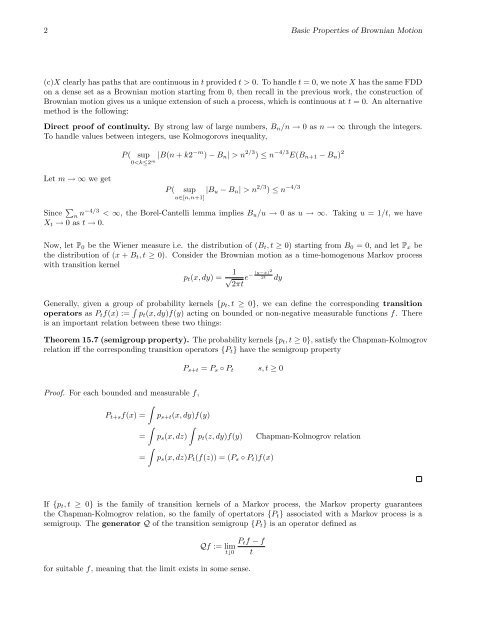Basic Properties of Brownian Motion
Basic Properties of Brownian Motion
Basic Properties of Brownian Motion
Create successful ePaper yourself
Turn your PDF publications into a flip-book with our unique Google optimized e-Paper software.
2 <strong>Basic</strong> <strong>Properties</strong> <strong>of</strong> <strong>Brownian</strong> <strong>Motion</strong><br />
(c)X clearly has paths that are continuous in t provided t > 0. To handle t = 0, we note X has the same FDD<br />
on a dense set as a <strong>Brownian</strong> motion starting from 0, then recall in the previous work, the construction <strong>of</strong><br />
<strong>Brownian</strong> motion gives us a unique extension <strong>of</strong> such a process, which is continuous at t = 0. An alternative<br />
method is the following:<br />
Direct pro<strong>of</strong> <strong>of</strong> continuity. By strong law <strong>of</strong> large numbers, Bn/n → 0 as n → ∞ through the integers.<br />
To handle values between integers, use Kolmogorovs inequality,<br />
Let m → ∞ we get<br />
P ( sup<br />
0 n 2/3 ) ≤ n −4/3 E(Bn+1 − Bn) 2<br />
P ( sup |Bu − Bn| > n<br />
u∈[n,n+1]<br />
2/3 ) ≤ n −4/3<br />
Since <br />
n n−4/3 < ∞, the Borel-Cantelli lemma implies Bu/u → 0 as u → ∞. Taking u = 1/t, we have<br />
Xt → 0 as t → 0.<br />
Now, let P0 be the Wiener measure i.e. the distribution <strong>of</strong> (Bt, t ≥ 0) starting from B0 = 0, and let Px be<br />
the distribution <strong>of</strong> (x + Bt, t ≥ 0). Consider the <strong>Brownian</strong> motion as a time-homogenous Markov process<br />
with transition kernel<br />
pt(x, dy) = 1 (y−x)2<br />
− √ e 2t dy<br />
2πt<br />
Generally, given a group <strong>of</strong> probability kernels {pt, t ≥ 0}, we can define the corresponding transition<br />
operators as Ptf(x) := pt(x, dy)f(y) acting on bounded or non-negative measurable functions f. There<br />
is an important relation between these two things:<br />
Theorem 15.7 (semigroup property). The probability kernels {pt, t ≥ 0}, satisfy the Chapman-Kolmogrov<br />
relation iff the corresponding transition operators {Pt} have the semigroup property<br />
Ps+t = Ps ◦ Pt<br />
s, t ≥ 0<br />
Pro<strong>of</strong>. For each bounded and measurable f,<br />
<br />
Pt+sf(x) = ps+t(x, dy)f(y)<br />
<br />
= ps(x, dz) pt(z, dy)f(y) Chapman-Kolmogrov relation<br />
<br />
= ps(x, dz)Pt(f(z)) = (Ps ◦ Pt)f(x)<br />
If {pt, t ≥ 0} is the family <strong>of</strong> transition kernels <strong>of</strong> a Markov process, the Markov property guarantees<br />
the Chapman-Kolmogrov relation, so the family <strong>of</strong> opertators {Pt} associated with a Markov process is a<br />
semigroup. The generator Q <strong>of</strong> the transition semigroup {Pt} is an operator defined as<br />
Ptf − f<br />
Qf := lim<br />
t↓0 t<br />
for suitable f, meaning that the limit exists in some sense.



